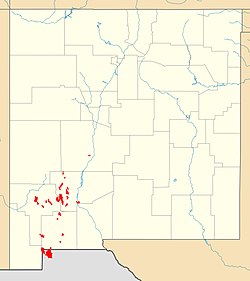| Percha Formation | |
|---|---|
| Stratigraphic range: Famennian PreꞒ Ꞓ O S D C P T J K Pg N | |
| Type | Formation |
| Sub-units | Ready Pay Member, Box Member |
| Underlies | Lake Valley Limestone, Caballero Formation, Escabrosa Limestone |
| Overlies | Fusselman Formation, Sly Gap Formation, Onate Formation |
| Thickness | 132 feet (40 m) |
| Lithology | |
| Primary | Shale |
| Other | Limestone |
| Location | |
| Coordinates | 32°54′57″N 107°31′36″W / 32.9159°N 107.5267°W / 32.9159; -107.5267 |
| Region | New Mexico |
| Country | United States |
| Type section | |
| Named for | Percha Creek |
| Named by | G.H. Gordon |
| Year defined | 1907 |
 | |
The Percha Formation is a geologic formation in southern New Mexico. It preserves fossils dating back to the Famennian Age of the late Devonian period.
Description
The formation consists mostly of black to gray shale and minor limestone. It rests on a regional unconformity, so that the underlying formation may be the Fusselman Formation, the Sly Gap Formation, or the Onate Formation. It underlies the Lake Valley Limestone, Caballero Formation, Escabrosa Limestone, or other Mississippian formations. Total thickness is about 132 feet (40 m).
The formation is divided into two members. The Ready Pay Member (formerly lower Percha) is mostly black fissile shale nearly devoid of fossils and with a total thickness of about 132 feet (40 m). The Box Member (formerly upper Percha), which is much less limited in areal extent, is about 47 feet (14 m) of gray to green calcareous shale with limestone nodules and beds. It is highly fossiliferous.
Fossils
The base of the formation contains fossils of arthrodiran fish, shark teeth, late Fammenian conodonts, brachiopods, and corals. The Box Member contains fossils of brachiopods, crinoids, bryozoans, sponges, corals, and late Fammenian conodonts.
History of investigation
The formation was first named as the Percha Shale by C.H. Gordon in 1907 for exposures at Percha Creek. However, a type section was not designated until 1945, by F.V. Stevenson. Stevenson also divided the formation into the lower Ready Pay Member and the upper Box Member. D. Schumacher and coinvestigators mapped the formation into southeastern Arizona and renamed it the Percha Formation in 1976.
See also
Footnotes
- ^ Kues 2004, pp. 65–67.
- ^ Gordon 1907.
- ^ Stevenson 1945.
- ^ Schumacher et al. 1976.
- Kues 2004, p. 65.
References
- Gordon, C.H. (1907). "Mississippian (Lower Carboniferous) Formations in the Rio Grande Valley, New Mexico". American Journal of Science. 24 (139). Retrieved 20 February 2021.
- Kues, B.S. (2004). "Devonian of New Mexico". In Mack, G.H.; Giles, K.A. (eds.). The geology of New Mexico. A geologic history: New Mexico Geological Society Special Volume 11. pp. 59–75. ISBN 9781585460106.
- Schumacher, D.; Witter, D.P.; Meader, S.J.; Keith, S.B. (1976). "Late Devonian tectonism in southeastern Arizona" (PDF). Arizona Geological Society Digest. 10: 59–70. Retrieved 5 August 2020.
- Stevenson, Frank V. (July 1945). "Devonian of New Mexico". The Journal of Geology. 53 (4): 217–245. doi:10.1086/625283.